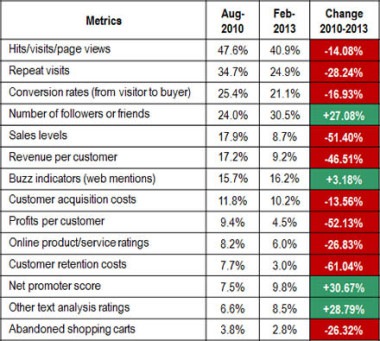Most businesses have accepted a social media presence is worthwhile, although many seem unable to back that feeling up with hard facts and figures. In a recent survey of 410 chief marketing officers almost half (49%) said they weren’t able to quantify whether social media has made a difference for their companies. 36% said they had a good sense of qualitative (though not quantitative) results, with only 15% reporting they had seen a proven quantitative impact.
In traditional marketing terms return on investment (ROI) is relatively straightforward to work out.
Put simply, ROI = (Return – Investment)/Investment
So if you spend $1,000 and make a return of $10,000 as a direct result of this investment the ROI would be:
(10,000 – 1,000)/1,000 = a return on investment of $9 for every $1 spent.
Variables on both the return and investment side of the equation can make the calculations more complex of course, but the basics remain the same. The problem in applying this formula to social media spending is the return is not always so clear.
How much is a ‘like’ or a retweet worth to your business in purely financial terms? How about a slightly nebulous concept like ‘spreading brand awareness’ or ‘fostering relationships’?
In many cases, social media ROI can be measured, especially for individual campaigns. But, it may require a different approach than more traditional marketing techniques.
The Changing Face of Social ROI Metrics
As marketers and other interested parties have gained a clearer picture of what social media can and can’t do for them, there has been a marked drop in purely financial metrics. From 2010 to 2013 the number of marketers using a revenue-per-customer metric as a main indicator fell from 17% to just 9%.
Other factors are seen as increasingly important (and measurable) signs of success include audience reach, engagement, and sentiment.
The CMO Survey looked at the metrics companies used most often to measure the success of their social media campaigns between 2010 and 2013, as displayed in this chart by Forbes:
 (Source: Forbes)
(Source: Forbes)Easily measurable data like the overall number of hits and repeat visitors remain the most commonly used metrics, but both have fallen over the past three years. The biggest drops were in purely financial metrics – sales levels, revenue per customer, profits per customer, and customer retention costs.
The highest upward swings were ‘voice metrics’ used to ascertain levels of engagement, attitude, and brand loyalty. The number of followers and friends is a simple enough way to track customers who could be considered to have an ongoing relationship with the brand. Text analysis (sometimes known as ‘opinion mining’) uses algorithms to determine sentiment from written material such as posts and tweets while Net Promoter Score is a customer loyalty metric based on the question ‘How likely is it that you would recommend our company/product/service to a friend or colleague?’
Measuring The Impact of Individual Campaigns
Customer engagement, attitude, and brand loyalty can all be very useful indicators, but there are also often opportunities to use financial metrics, especially across individual campaigns with defined goals.
Google Analytics is a great free tool for small businesses as it allows you to track how many visitors land at your main corporate website via your social media channels. You can also track how many of these visitors result in a conversion, whether this is a sale, a subscription to email marketing, or any other pre-defined action.
Social media exclusives such as vouchers and special offers with a direct click-through are another way to measure the effectiveness of any given campaign. You can also simply measure sales while a campaign is active versus sales before and after, although the waters can be muddied somewhat if you have a constant, ongoing social media presence and other campaigns, which may well be interlinked, are running at the same time.
The success of some individual campaigns will be easier to quantify than others. Texan coffee-house The Coffee Groundz, for example, used Twitter as a direct ordering channel and saw both sales and market share rise by 25%. Pennsylvanian green tea makers Steaz offered coupons via Twitter and Facebook and saw 250,000 downloaded, building an active community of more than 10,000 in the process. Chicago’s Foiled Cupcakes implemented a ‘relationship-building program’ over Twitter and Facebook and reported that 97% of its customers now originate from social media.
Social media marketing might be difficult to fit into the traditional model of ROI. But, by looking at specific parameters, setting goals, and expanding your definition of value, it is more than possible to measure the success of individual campaigns and your ongoing social presence.
Image created by author




